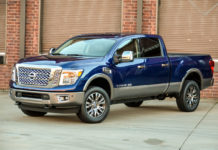It's no secret that Mitsubishi's concept Prototype X, unveiled at the North American International Auto Show in Detroit earlier this year, is basically how the next Lancer Evolution will look, but there will be minor differences between it and the final version.

The production model will have round foglights inside the front bumper, and the side mirrors will be slightly different. The images you see here represent the finished appearance, including the 18-in. alloy BBS wheels shod with Bridgestone Potenza 245/40R-18 tires. With a name that can stretch as long as that of an Arabian king, Mitsubishi may drop “Lancer” and the numerical designation from the car's official name, but for now, we'll refer to it as the Evo X (Ten).
At first glance the Evo X looks significantly larger than the current model (the Evo IX), but actually, it's a tad shorter. Overall width and height have grown slightly, and the wheelbase has been stretched to 103.7 in., which results in more interior space and better overall ride quality.
While Mitsubishi was eager to let everyone see how the next Evo will look, the company has carefully kept all technical information hidden away in a bento box deep within the confines of its global and North American headquarters, located in Tokyo, Japan, and Cypress, California, respectively. Hungry for this information, we sent our spies and insiders to track down the protected material, and they came back with the mother lode.
At the heart of the Evo X is an all-new aluminum 2.0-liter inline-4, codenamed 4B11. This powerplant features MIVEC (Mitsubishi's variable valve technology), four valves per cylinder and a big turbocharger. Recent estimates put output at roughly 300 bhp peaking at about 7000 rpm and 325 lb.-ft. of torque coming at a low 3000, both noticeable increases from the Evo IX. Also, this new 4-banger is lighter than the previous engine by about 50 lb.
A standard 5-speed manual gearbox and a new 6-speed twin-clutch automatic with manual mode, codenamed SST, will be offered. The latter is similar to Volkswagen's DSG, meaning that it's essentially a manual transmission that has a seamless full automatic mode. In manual mode, up- and downshifts are performed sequentially via paddles behind the steering wheel, with each gear change performed faster than any human hand. An anonymous source inside the company claims that this new transmission will be better than VW's.
“Because ours comes well after Volkswagen's version, we needed to make it noticeably better or our customers won't be satisfied. And we're talking about the Evo here, so the feeling is that if our semiautomatic isn't perfect, we'd be better off offering just a conventional manual transmission,” he said. Expect the car's 0-60-mph and quarter-mile times to remain about the same as the Evo IX's, maybe slightly better with the SST because of quicker upshifts.
Price
est $32,000
Curb weight
est 3500 lb
Wheelbase
103.7 in.
Length
est 180.0 in.
Width
est 71.5 in.
Height
est 58.0 in.
Type
alum. block & head, turbo inline-4
Valves
4-valves/cyl
Displacement
1998 cc
Horsepower
est 300 bhp @ 7000 rpm
Torque
325 lb-ft @ 3000 rpm
Transmission
6-speed semiautomatic
Layout
front engine/awd
Body/frame
unit steel
Brakes, f&r
vented discs, ABS
Steering
rack & pinion, variable pwr assist
Suspension, f/r
MacPherson struts/multilink
Wheels
forged alloy, 18 in.
Tires
Bridgestone Potenza, 245/40R-18
0–60 mph
est 4.5 sec
0–1320 ft (¼ mile)
est 12.5 sec
The Evo has built its reputation on being one of the best-handling cars in the world — things get even better with the new car. The suspension geometry of the Ten will remain relatively unchanged, but forged aluminum pieces are now used throughout to keep weight down. The new Evo is heavier than the model it replaces, weighing about 3500 lb., but the chassis is much stiffer. Also, ride quality will be smoother. But don't think for a moment that its cornering prowess has been compromised.
For the first time ever, U.S.-spec Lancer Evolutions will be equipped with AYC (active yaw control) and S-AWC (super-all-wheel control), as well as ACD (active center differential) and ASC (anti-skid control). AYC helps prevent the car from under- and oversteering severely via sensors that measure the car's speed and lateral acceleration. S-AWC, new in Evos worldwide, works in conjunction with AYC. It monitors the car's yaw rate to predict where the driver wants to go, then makes sure he gets there by slightly modulating the throttle and brakes. Purists need not worry because the system hardly interferes with the driving experience.
Unlike most active yaw-control systems that reduce vehicle speed to counter under- and oversteer, S-AWC's objective is to use them to increase the handling limits of the car. So when you step on the throttle in mid-turn, and the front or rear tires lose some traction, S-AWC won't automatically cut engine power or slam the brakes. It'll allow some tire slippage, and help you stay on your driving line. Only when it senses that you're nearing the point of no return will it resort to more extensive measures.
The tenth version of the Lancer Evolution will no doubt be the most civil and comfortable ever, but Mitsubishi was careful not to mess with the sharp-edged nature that has defined past Evos. And it'll still be a relative bargain. We predict a base version to come in around $32,000 with the top-of-the-line model hitting about $36,000. A 5-door hatchback is expected to join the lineup sometime later in 2008, but whether that car comes to the U.S. remains to be seen.
Source: Road & Track








